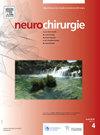Prioritizing clinical indicators over radiological findings in the management of chronic subdural hematoma associated with spontaneous intracranial hypotension
IF 1.4
4区 医学
Q4 CLINICAL NEUROLOGY
引用次数: 0
Abstract
Objective
Chronic subdural hematoma (CSDH) is a well-documented imaging finding in spontaneous intracranial hypotension (SIH) and is often managed conservatively. While large hematomas identified on imaging traditionally prompt early surgical intervention, this approach still seems unclear. This study aims to clarify optimal management strategies by reviewing our clinical experience.
Methods
We retrospectively analyzed 14 consecutive cases of CSDH associated with SIH treated at our institution between 2010 and 2024. Patient demographics, clinical symptoms, and imaging findings were extracted from medical records and statistically analyzed.
Results
Seven patients with persistent headaches underwent hematoma drainage in addition to SIH treatment, whereas seven patients with positional headaches were successfully managed with SIH treatment alone. The persistent headache group had a larger median hematoma volume than the positional headache group (88.9 cm3 vs. 38.9 cm³). However, the persistent headache group had a significantly lower median Glasgow Coma Scale score than the positional headache group (13 vs. 15, p = 0.011). Papilledema was observed in five of the seven patients in the persistent headache group, but was absent in the positional headache group (p = 0.079).
Conclusions
Our study demonstrates that clinical indicators—particularly papilledema, altered consciousness, and headache characteristics—are essential for guiding the need for hematoma drainage in CSDH associated with SIH. Radiological features such as hematoma volume were not sufficient predictors of surgical need.
在处理自发性颅内低血压相关的慢性硬膜下血肿时,优先考虑临床指标而不是影像学表现
目的慢性硬膜下血肿(CSDH)是自发性颅内低血压(SIH)的影像学表现,通常采用保守治疗。虽然影像学上发现的大血肿通常会提示早期手术干预,但这种方法仍然不清楚。本研究旨在通过回顾我们的临床经验来阐明最佳的治疗策略。方法回顾性分析我院2010年至2024年间连续收治的14例CSDH合并SIH患者。从医疗记录中提取患者人口统计学、临床症状和影像学结果并进行统计分析。结果7例持续性头痛患者行血肿引流治疗,7例体位性头痛患者单用SIH治疗成功。持续性头痛组中位血肿体积大于体位性头痛组(88.9 cm3比38.9 cm³)。然而,持续性头痛组的格拉斯哥昏迷评分中位数明显低于体位性头痛组(13比15,p = 0.011)。持续性头痛组7例患者中有5例出现乳头水肿,体位性头痛组无乳头水肿(p = 0.079)。结论我们的研究表明,临床指标——尤其是乳头水肿、意识改变和头痛特征——对于指导伴有SIH的CSDH是否需要进行血肿引流至关重要。血肿体积等放射学特征不能充分预测手术需求。
本文章由计算机程序翻译,如有差异,请以英文原文为准。
求助全文
约1分钟内获得全文
求助全文
来源期刊

Neurochirurgie
医学-临床神经学
CiteScore
2.70
自引率
6.20%
发文量
100
审稿时长
29 days
期刊介绍:
Neurochirurgie publishes articles on treatment, teaching and research, neurosurgery training and the professional aspects of our discipline, and also the history and progress of neurosurgery. It focuses on pathologies of the head, spine and central and peripheral nervous systems and their vascularization. All aspects of the specialty are dealt with: trauma, tumor, degenerative disease, infection, vascular pathology, and radiosurgery, and pediatrics. Transversal studies are also welcome: neuroanatomy, neurophysiology, neurology, neuropediatrics, psychiatry, neuropsychology, physical medicine and neurologic rehabilitation, neuro-anesthesia, neurologic intensive care, neuroradiology, functional exploration, neuropathology, neuro-ophthalmology, otoneurology, maxillofacial surgery, neuro-endocrinology and spine surgery. Technical and methodological aspects are also taken onboard: diagnostic and therapeutic techniques, methods for assessing results, epidemiology, surgical, interventional and radiological techniques, simulations and pathophysiological hypotheses, and educational tools. The editorial board may refuse submissions that fail to meet the journal''s aims and scope; such studies will not be peer-reviewed, and the editor in chief will promptly inform the corresponding author, so as not to delay submission to a more suitable journal.
With a view to attracting an international audience of both readers and writers, Neurochirurgie especially welcomes articles in English, and gives priority to original studies. Other kinds of article - reviews, case reports, technical notes and meta-analyses - are equally published.
Every year, a special edition is dedicated to the topic selected by the French Society of Neurosurgery for its annual report.
 求助内容:
求助内容: 应助结果提醒方式:
应助结果提醒方式:


